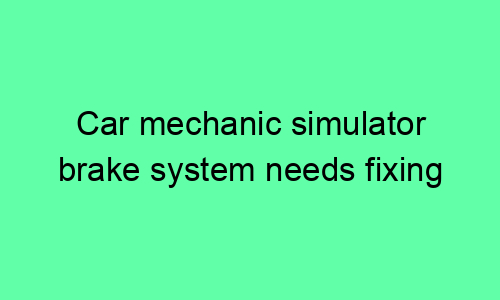## Car Mechanic Simulator: Comprehensive Guide to Brake System Diagnosis and Repair
### Introduction
The brake system is a critical component of any vehicle, ensuring safe and controlled stopping. In Car Mechanic Simulator, brake problems can arise during repairs or vehicle assessments. This guide provides a comprehensive overview of brake system diagnosis and repair procedures in the game.
### Identifying Brake Issues
Various indicators can suggest brake system problems:
– **Soft or spongy brake pedal:** Air in the brake lines or a faulty master cylinder.
– **Squealing or grinding noises:** Worn brake pads or rotors.
– **Uneven braking:** Sticky calipers or uneven pad wear.
– **Vehicle pulling to one side:** Sticking calipers or a seized wheel cylinder.
– **Leaking brake fluid:** Damaged brake lines, hoses, or master cylinder.
### Diagnosing the Problem
To diagnose the root cause of brake issues, follow these steps:
1. **Visual inspection:** Examine brake components for wear, damage, or leaks.
2. **Brake fluid level:** Check the master cylinder reservoir for adequate fluid levels.
3. **Brake pedal feel:** Pump the brake pedal to assess its firmness and identify any sponginess.
4. **Brake line pressure:** Use a pressure gauge to measure brake line pressure and identify any blockages or leaks.
5. **Calipers and wheel cylinders:** Inspect calipers and wheel cylinders for binding or leaks.
6. **Brake pads and rotors:** Remove wheels to check pad thickness and rotor condition.
### Repairing the Brake System
Once the problem is identified, repair procedures can include:
1. **Bleeding brake lines:** Remove air from brake lines using a bleeder screw and brake fluid.
2. **Replacing brake pads and rotors:** Remove worn components and install new ones.
3. **Rebuilding calipers or wheel cylinders:** Disassemble and replace seals or pistons as needed.
4. **Repairing brake lines or hoses:** Replace damaged lines or hoses to prevent leaks.
5. **Replacing the master cylinder:** Remove and install a new master cylinder if it is faulty.
### Special Considerations
– **ABS (Anti-lock Braking System):** Check ABS sensors, wires, and modules for faults.
– **Power brakes:** Inspect the vacuum booster or electric pump for proper operation.
– **Electronic brake control (EBC):** Utilize diagnostic tools to identify faults in electronic systems.
### Tips for Efficient Repairs
– Use the correct tools and equipment for each task.
– Refer to the vehicle’s service manual for specific repair procedures.
– Inspect related components, such as brake hoses, lines, and calipers, during repairs.
– Test the brake system thoroughly after repairs to ensure proper functionality.
– Regularly maintain the brake system to prevent future issues.
### Conclusion
Mastering brake system diagnosis and repair in Car Mechanic Simulator is essential for accurate vehicle assessments and safe driving simulations. By following the steps outlined in this guide, players can confidently troubleshoot and fix brake problems, ensuring optimal vehicle performance and safety.






